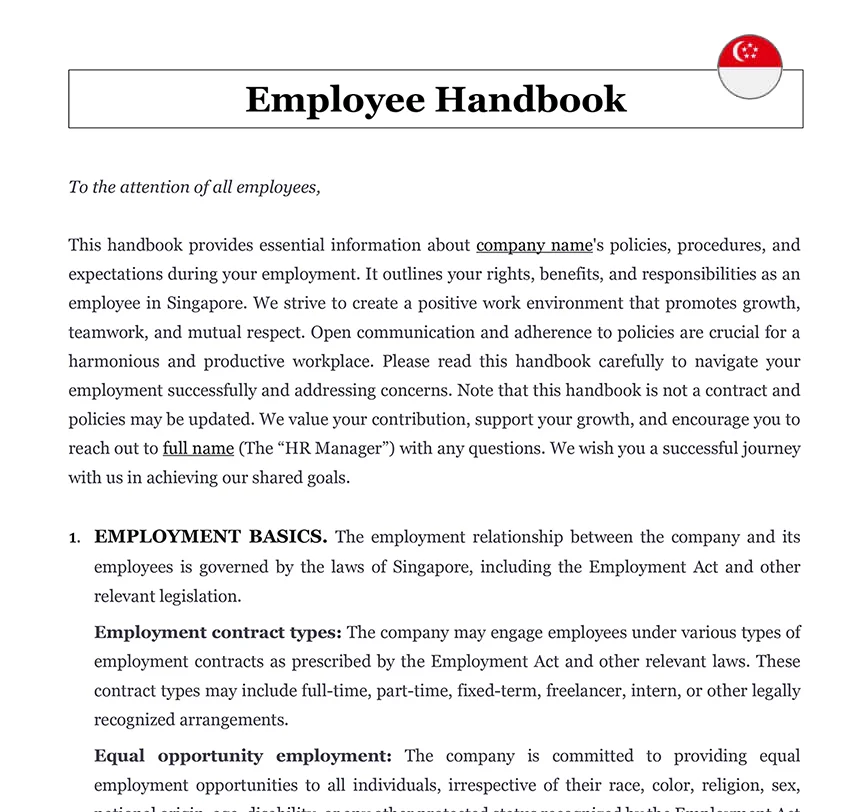Ready to use legal template
Drafted by experienced lawyers
Compliant with Singapore law
Ready to use legal template
Drafted by lawyers
Compliant with Singapore law
Learn more about Employee Handbook in Singapore
An Employee Handbook is an essential document that outlines a company’s policies, procedures, and expectations for employees. It serves as a central reference guide covering areas such as code of conduct, working hours, leave entitlements, disciplinary procedures, and employee benefits. In Singapore, having a clear and comprehensive Employee Handbook helps employers communicate their workplace rules effectively and ensures compliance with the Employment Act and related regulations. It also protects the organisation by clarifying employee rights and responsibilities, reducing the risk of disputes. Whether for startups or established companies, this document supports a transparent and productive work environment. Download our Employee Handbook available in an easy to edit Word format and drafted by expert to be used in Singapore.
Table of contents
-
What is the purpose of an Employee Handbook?
-
What does an Employee Handbook include?
-
How does it address issues such as working hours?
-
What are the consequences of non-compliance?
-
Can an employer make changes without employee consent?
-
Are there provisions regarding termination of employment?
-
What if I don’t have an Employee Handbook?
What is the purpose of an Employee Handbook?
The purpose of an employee handbook in Singapore is to provide a comprehensive guide that outlines the rights, responsibilities, and expectations of both employers and employees within an organization. It serves as a valuable resource that communicates the company’s policies, procedures, and practices, ensuring clarity and consistency in the workplace.
The handbook typically covers a wide range of topics, including but not limited to employment terms and conditions, code of conduct, leave entitlements, grievance procedures, disciplinary actions, and health and safety regulations.
By providing this information, it promotes transparency, sets clear guidelines, and helps foster a positive work environment that is compliant with Singapore’s employment laws and regulations. It also acts as a reference tool for employees, allowing them to understand their rights and obligations while serving as a point of reference for dispute resolution or conflict management.
What does an Employee Handbook include?
1. Employment Basics
Equal opportunity employment: Ensuring fair treatment and non-discrimination.
Recruitment and selection process: Guidelines for hiring and candidate selection.
Background checks: Procedures for conducting background checks on potential employees.
Referrals: Policies for employee referrals and rewards.
Attendance: Expectations for punctuality and attendance.
2. Workplace Policies
Confidentiality and data protection: Safeguarding sensitive company and employee information.
Harassment and violence: Policies addressing various forms of harassment in the workplace.
Workplace safety and health: Guidelines for maintaining a safe and healthy work environment.
Preventative action: Steps to prevent workplace incidents and accidents.
Emergency management: Procedures for handling emergencies and evacuation.
Smoking: Policies regarding smoking in the workplace.
Drug-free workplace: Prohibition of drug use on company premises.
3. Employee Code of Conduct
Dress code: Expectations for appropriate attire.
Cyber security and digital devices: Guidelines for safe and responsible use of company technology.
Internet usage: Policies for internet usage during work hours.
Cell phone: Guidelines for cell phone use in the workplace.
Social media: Policies governing employee use of social media platforms.
Conflict of interest: Policies addressing situations where personal interests conflict with company interests.
Employee relationships: Guidelines for professional relationships among employees.
Workplace visitors: Policies for visitors and guests in the workplace.
4. Employee Compensation and Development
Compensation status: Information on salary structure and payment procedures.
Overtime: Guidelines for compensating overtime work.
Performance management: Processes for evaluating and managing employee performance.
Employee training and development: Opportunities for employee growth and development.
5. Employee Benefits and Perks
Employee health: Information on healthcare benefits and coverage.
Workers’ compensation: Policies related to workplace injuries and insurance coverage.
Work from home: Guidelines for remote working arrangements.
Employee expenses: Procedures for reimbursement of approved expenses.
Company car: Policies regarding the use and maintenance of company-provided vehicles.
6. Working Hours, PTO and Vacation
Working hours: Expectations for regular work hours and breaks.
Paid time off (PTO): Guidelines for requesting and using paid leave.
Holidays: List of company-recognized holidays and leave entitlements.
Sick leave: Policies for reporting and taking sick leave.
Parental leave: Entitlements and procedures for parental leave.
7. Employee Resignation and Termination
Progressive discipline: Steps taken in addressing employee performance or behavioral issues.
Resignation: Procedures for employees who wish to resign from their positions.
Termination: Guidelines and procedures for terminating an employee’s employment.
References: Policies regarding providing employee references.
- Remarks:
It is important to note that the content of the handbook may vary depending on the nature of the organisation, industry-specific regulations, and company policies.
How does it address issues such as working hours?
It addresses issues such as working hours by clearly outlining the company’s policies and expectations regarding working hours.
| ➤ It specifies the standard working hours, breaks, and rest periods, in accordance with Singapore's labor laws. |
| ➤ The handbook may also mention any flexible work arrangements or alternative work schedules that the company offers, such as flexitime or telecommuting options, if applicable. |
| ➤ It may explain the procedures for requesting overtime work, the compensation for overtime hours, and the process for obtaining approval for working beyond regular hours. |
| ➤ By addressing these issues, the handbook ensures transparency and consistency in managing working hours, enabling employees to understand their rights and obligations while providing a framework for the company to maintain compliance with employment regulations. |




